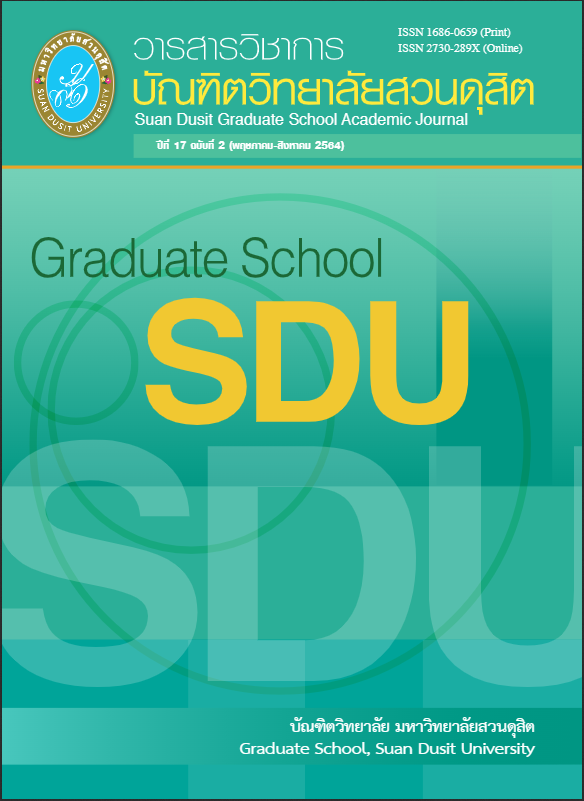Approaches for Bull Fighting Event Tourism Brand Development of Songkla Province, Thailand
Keywords:
Tourism Brand Development, Bull Fighting Event, SongkhlaAbstract
This research aimed to 1) study the potential of brand development of bull fighting event tourism in Songkhla and 2) to propose the guidelines of brand development of bull fighting vent tourism in Songkhla. The qualitative research method and participatory action research were used. There were 32 key informants from governmental and private sectors, people, and tourists in Songkhla recruited by the purposive sampling method. The in-depth interview and participatory observation were used to collect the data. The findings revealed that 1) Songkhla had the potential to develop bull fighting event tourism in many aspects, including potential in providing information in order to present bull fighting event tourism to customers, having unique bull events, and being the center of bull fighting event tourism internationally and in ASEAN. 2) Guidelines for bull fighting event tourism brand development were (1) The building of networks and the affiliation of the international organizations for cooperation and coordination, which helped develop bull fighting event tourism, such as country, regional, and provincial confederations. (2) The determination of the places to hold bull fighting event tourism and the development of the key ideas about the places to hold these events. (3) The recommended extension of the longer period of the international event such as 5-10 days. (4) Songkhla's strategic planning of bull fighting event tourism as to become the center of the event in ASEAN and internationally. (5) The creation of the website to support bull fighting event tourism brands in Songkhla province and the integration with social media such as facebook, twitter to develop the digital marketing on the internet.
References
พจนา สวนศรี. (2546). คู่มือการจัดการท่องเที่ยวโดยชุมชน. กรุงเทพฯ: โครงการท่องเที่ยวเพื่อชีวิต และธรรมชาติ.
พะยอม ธรรมบุตร. (2559). เอกสารประกอบการเรียนการสอนการศึกษาเพื่อการท่องเที่ยว. กรุงเทพฯ: วิทยาลัยการจัดการ มหาวิทยาลัยพะเยา.
วิเชียร ณ นคร. (2542). วัวชน. ในสารนุกรมวัฒนธรรมไทยภาคใต้ เล่ม 4. กรุงเทพฯ: มูลนิธิ สารานุกรมวัฒนธรรมไทย ธนาคารไทยพาณิชย์.
รงค์ บุญสวยขวัญ. (2559). การเมืองของการพนันวัวชนภาคใต้. วารสารมนุษยศาสตร์และสังคมศาสตร์มหาวิทยาลัยวลัยลักษณ์สุราษฎร์ธานี. 8 (3): 242-266.
สมหมาย คล้ายบ้านใหม่. (2543). พลวัตของกีฬาชนโคในบริบทการท่องเที่ยว: กรณีศึกษา สนามชนโคบ้านบางกล่ำ จังหวัดสงขลา. คณะมนุษย์ศาสตร์และสังคมศาสตร์ มหาวิทยาลัยราชภัฏสงขลา, 1 (1): 319-325.
สุธีรพันธุ์ สักรวัตร. (2559). สร้างแบรนด์ในยุค Branding 4.0. Positioning. สืบค้นเมื่อ 25 มกราคม 2563 จาก http://www.positioningmag.com.
สุพิชฌาย์ รัตนะ (2547). ยกระดับ "ชนวัว" กีฬาพื้นบ้านเพื่อการท่องเที่ยว. สืบค้นเมื่อ 14 พฤศจิกายน 2563 จาก http://www.nationtv.tv/main/content.
สุภางค์ จันทวานิช. (2546). วิธีการเก็บข้อมูลในการวิจัยเชิงคุณภาพ. ในคู่มือการวิจัยเชิงคุณภาพเพื่องานพัฒนา, อุทัย ดุลยเกษม (พิมพ์ครั้งที่ 4). ขอนแก่น: สำนักพิมพ์แห่งมหาวิทยาลัยขอนแก่น.
สุทธิวงศ์ พงศ์ไพบูลย์. (2543). กะเทาะสนิมกริชและวิถีชีวิตชาวใต้ตอนล่าง. กรุงเทพฯ: สำนักงานกองทุนสนับสนุนการวิจัย.
สำนักงานคณะกรรมการพัฒนาการเศรษฐกิจและสังคมแห่งชาติ. (2560). การพัฒนาการท่องเที่ยวของ ยุทธศาสตร์การพัฒนาของแผนพัฒนาเศรษฐกิจและสังคมแห่งชาติ. สืบค้นเมื่อ 20 มกราคม 2563 จาก http://www.nesdb.go.th.
อาคม เดชทองคำ. (2543). หัวเชื่อกวัวชน. กรุงเทพฯ: สำนักงานกองทุนสนับสนุนการวิจัย.
เอื้อมพร หลินเจริญ. (2554). การพัฒนารูปแบบการจัดกระบวนการเรียนรู้ เรื่องการศึกษาชุมชนเพื่อสืบค้นองค์ความรู้และภูมิปัญญาท้องถิ่น โครงการทุนวิจัย. สำนักงานการวิจัยแห่งชาติ (วช.).
Hankinson, G. (2006). The Management of Destination Brands: Five Guiding Principles based on Recent Developments in Corporate Branding Theory," Journal of Brand Management, 14 (3): 240-254.
Kotler, P., Haider, D. and Rein, 1. (1993). Marketing Places: Attracting Investment, Industry, and Tourism to Cities, States, and Nations. The Free Press.
McMillan, J. H. and Schumacher, S. S. (1997). Research in Education: A Conceptual Introduction. New York: Longman.
Prentice, R. & Andersen, V. (2003). Festival as Creative Destination. Annals of Tourism Research, 30 (1): 7-30.
Russo A. (2002). The Vicious Circle of Tourism Development in Heritage Cities. Annals of Tourism Research, 29 (1): 165-182.
UNESCO and Institute for Tourism Studies (IFT). (2007). A Training Manual for Heritage Guides Tourism at Cultural Heritage Sites in Asia Cultural Heritage Specialist Guide Training and Certification Program for UNESCO World Heritage Sites. Macao: UNESCO and Institute for Tourism Studies (IFT), Macao SAR.
Downloads
Published
How to Cite
Issue
Section
License
Copyright (c) 2021 Suan Dusit Graduate School Acadamic Journal

This work is licensed under a Creative Commons Attribution-NonCommercial-NoDerivatives 4.0 International License.






